A: We’d like to welcome back Mr. Enrique Fernandez of Switzerland. In his first letter to VOV since 1961, he wrote: “I had the pleasure of hearing your broadcasts in English from Hanoi on October 21, 2018 between 21:20 and 21:53 UTC on 9730 khz with a SINPO of 34222 (weak, fading signal, some atmospheric noise). I really enjoyed listening to your station once again.”
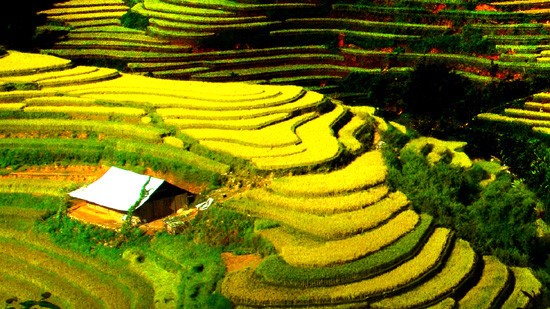 A terraced field in Mu Cang Chai in Yen Bai province A terraced field in Mu Cang Chai in Yen Bai province |
B: Thank you, Mr. Fernandez, for resuming listening to VOV. It has been a very long time since you last listened. It’s great to hear from you again. We hope you will keep listening and send us more feedback. Our programs are now also available online at vovworld.vn, where you can hear both live and recorded programs. Check out our VOV Media App available on both IOS and Android platform to hear our live broadcasts. We look forward to your feedback on the mobile version of vovworld.vn.
A: We continue to receive feedback from Mr. Fumito Hokamura who regularly reported on our broadcasts throughout September. In his letters, Mr. Hokamura asked about wet rice cultivation in Vietnam.
B: Thank you, Mr. Hokamura, for your regular feedback on our programs. Of the 54 ethnic groups in Vietnam, it was the Viet or Kinh people who settled in the Red River delta and engaged in wet rice cultivation. Through different stages of development, wet rice cultivation not only fed the people but also created a culture – the Red River civilization.
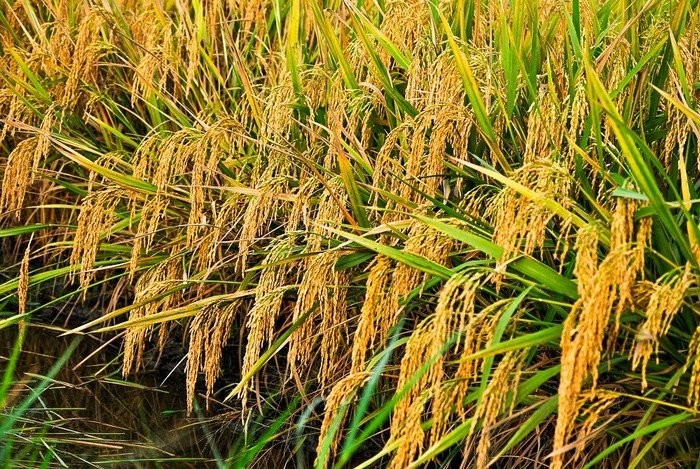 Rice field in northern Vietnam Rice field in northern Vietnam |
A: The Red River delta, formed by the alluvial deposits of two major rivers - the Red River and Thai Binh River - was the original habitation of the ancient Viet people. The Viet ancestors tamed wild rice for cultivation. Taking advantage of tropical factors such as hot, humid weather and abundant ponds and rivers, they made wet rice cultivation their means of livelihood.
B: Naturally, rice became their staple food and their meals consisted mainly of boiled rice, vegetables, and fish. Throughout their history, the Viet people have steadily gained experience in rice growing, irrigation, dyke building, canal digging, and techniques to increase crops. People’s lives have depended largely on nature, which has shaped customs, habits, rituals and beliefs such as worshipping ancestors and the Gods of Rain, Wind, Thunder and Lightning.
A: The Red River delta civilization has produced a wide range of arts, including cheo classical opera and water puppetry.
B: This week, we have received feedback on the programs on the website at www.vovworld.vn. Visit our website or use our VOV Media app to listen to our FM programs with a longer duration and more content. Many listeners have expressed their interest in those programs, especially “Food Delight”, “Culture Rendezvous” and “That’s life”. After listening to Food Delight, Wasef Rousan wrote: “I am a master chef and would like to participate in your Food Delight. I cook Turkish and Greek food. Thank you.”
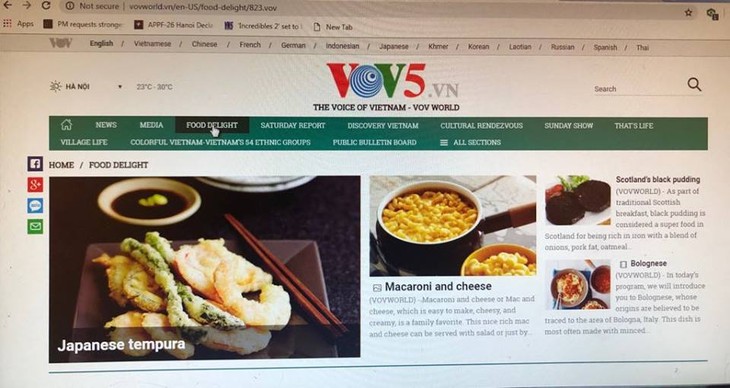 "Food Delight" segment on vovworld.vn "Food Delight" segment on vovworld.vn |
A: It’s great to hear from you, Wasef Rousan. On “Food Delight”, we introduce dishes from Vietnam and other countries around the world and share recipes to make them. We talk to Vietnamese and foreign chefs to learn about the culinary cultures and cooking tips of different countries. We also invite foreign chefs to share their cooking tips with us. We’ll contact Wasef about possibly appearing on our show.
B: Food is one of Vietnam’s top attractions for foreigners. Three Vietnamese dishes - bún riêu cua (noodle soup with freshwater crab), snails and bánh mì - were listed among the top 21 dishes of the year by the Australian travel website Traveller.
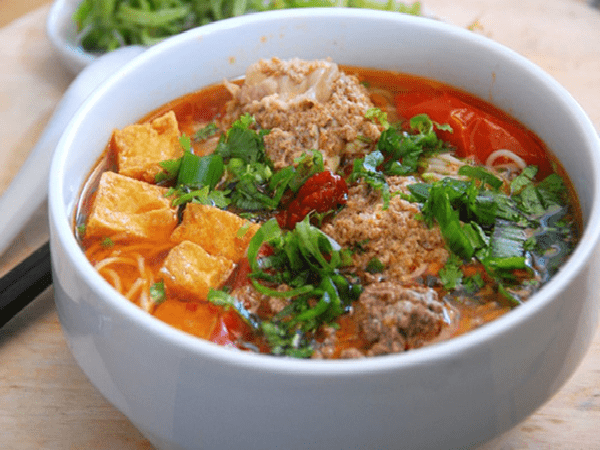 Bún riêu cua - Vietnamese noodle soup with freshwater crab Bún riêu cua - Vietnamese noodle soup with freshwater crab |
A: Bún riêu cua was described as "highly flavoursome" and “almost unfairly inexpensive” at 1.5 USD a bowl. This noodle dish, popular throughout Vietnam is a fragrant soup with crushed freshwater crabs, noodles, crab, fried tofu, pork and fresh herbs.
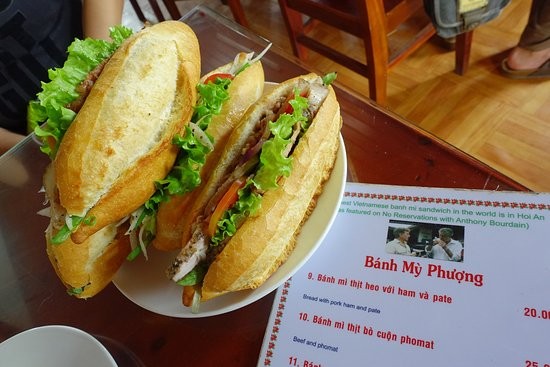 Hoi An’s Bánh mì Phượng is hailed as "a symphony within a sandwich" by the late world famous chef Anthony Bourdain Hoi An’s Bánh mì Phượng is hailed as "a symphony within a sandwich" by the late world famous chef Anthony Bourdain |
B: Hoi An’s Bánh mì Phượng was hailed as "a symphony within a sandwich" by the late world famous chef Anthony Bourdain. Snails, a very common dish in Vietnam still seems exotic to many foreign foodies. Different types of snails with different methods of cooking – pan-fried, grilled, boiled, simmered are “all delicious, particularly when paired with cold beer and a humid evening.”
A: Vietnamese cuisine is often featured in foreign media, particularly Vietnamese bread. It was listed as one of the world’s most delicious street foods by the Huffington Post and has been covered on CNN, authenticfoodquest.com, and the BBC.
B: In a story about Hoi An’s Banh Mi Phuong, a CNN reporter wrote: “The most famous banh mi in the world, Banh Mi Phuong sells roughly 3,000-4,000 sandwiches per day. The most important thing about banh mi is the bread. It has to be fresh -- crispy on the outside, soft on the inside. Now they have a steady stream of fresh baguettes."
A: “As for the taste? The restaurant has one of the largest menus with everything from vegetarian banh mi to bacon and beef. In the traditional version, the baguette explodes with fresh ingredients, such as barbecued pork, spicy chili, a bundle of fresh herbs and yolky mayonnaise,” CNN wrote.
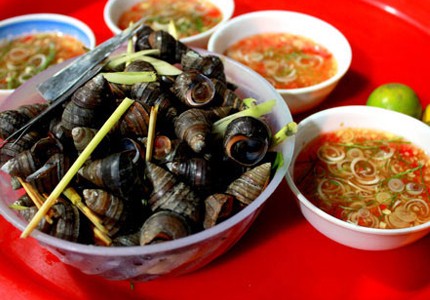 Boiled snails is a popular dish in Vietnam, particularly in Hanoi Boiled snails is a popular dish in Vietnam, particularly in Hanoi |
B: Tasting is believing. Come to Vietnam and enjoy the authentic flavor and taste of Vietnamese food.
A: This week, Richard Nowak of the US provided his frequent feedback on our broadcasts and our Sunday Show might be his favorite. He wrote: “I enjoyed tonight’s show on 7315 khz from 0:00 to 0:27 UTC. This was the best reception on a Sunday night in weeks. The Sunday Show was great. The idea of offering cooking classes to tourists and visitors is brilliant. With a great food culture like Vietnam’s this class would attract eager tourists looking to immerse themselves in the local culture. Great idea! “
B: Thank you, Mr. Nowak, for your regular feedback. In this week’s Sunday Show, we’ll feature the unique earthern houses and the traditional New Year festival of the Ha Nhi ethnic minority group in the northern mountainous province of Lai Chau. So stay tuned. We welcome your feedback at: English Service, VOVWORLD, the Voice of Vietnam, 45 Ba Trieu Street, Hanoi, Vietnam. Or you can email us at: englishsection@vov.org.vn. You’re invited to visit us online at vovworld.vn, where you can hear both live and recorded programs. Check out our VOV Media App available on both the IOS and Android platform to hear our live broadcasts. We look forward to your feedback on the mobile version of vovworld.vn. Once again, thank you all for listening. Goodbye until next time.